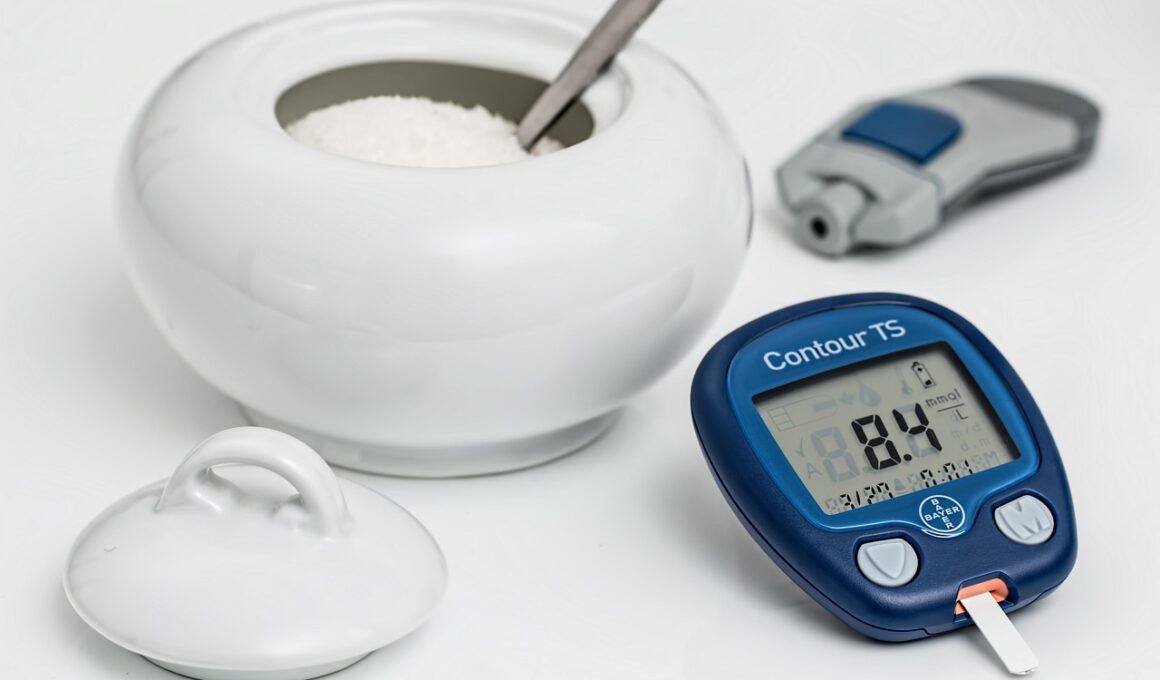How High-Intensity Interval Training Affects Blood Sugar Levels
High-Intensity Interval Training, often referred to as HIIT, has gained popularity for its efficiency in improving overall fitness and health. Research shows that HIIT can significantly impact blood sugar levels, particularly for individuals with insulin resistance or diabetes. By engaging in short bursts of intense exercise, followed by recovery periods, the body learns to utilize glucose more effectively. This training method helps in reducing insulin levels, thereby improving metabolic health. Consequently, people engaging in HIIT may experience improved blood sugar control and overall glucose metabolism. This increase in insulin sensitivity can be particularly beneficial for managing chronic conditions, as noted in various studies. Additionally, HIIT can lead to lower fasting blood sugar levels due to the increased caloric burn that continues after the workout. Understanding the relationship between HIIT and blood sugar management is essential for individuals aiming to enhance their fitness levels while managing chronic diseases. This overview provides insights into how incorporating this form of exercise can positively affect blood sugar regulation.
Regular participation in HIIT also contributes to improved cardiovascular health through increased heart rate and enhanced circulation. The changes in blood sugar levels can be attributed to this intense workout’s effect on skeletal muscles and their capacity to take up glucose. HIIT can stimulate the body to produce more mitochondria, thereby enhancing the efficiency of energy production in cells. Moreover, the additional muscle mass gained from HIIT can further aid in glucose uptake and utilization, which is crucial for maintaining optimal blood sugar levels. Individuals with type 2 diabetes may particularly benefit from incorporating HIIT into their fitness regimen as it encourages weight loss and reduces body fat percentage. This comprehensive approach to fitness not only aids in managing blood sugar but also promotes overall mental health by reducing stress and anxiety. When competing in HIIT routines, participants often report an increase in stamina and endurance, leading to a more energetic lifestyle. Therefore, exploring various HIIT exercises can yield significant changes in blood sugar management for various populations.
Effects of HIIT on Insulin Sensitivity
One of the most significant impacts of HIIT on blood sugar levels is its role in enhancing insulin sensitivity. Improved insulin sensitivity allows the body to utilize glucose more effectively, reducing blood sugar spikes after meals. Studies suggest that incorporating HIIT can lead to a considerable decrease in insulin resistance, making it easier for individuals to manage their blood sugar levels throughout the day. Insulin’s primary role is to facilitate glucose transport into cells, and when sensitivity is heightened, less insulin is required to perform this function. This metabolic change is crucial for those with diabetes, as it directly contributes to better blood sugar management. Additionally, consistent HIIT workouts promote hormonal changes that support this enhanced sensitivity. Growth hormone and catecholamines released during these intense workouts play a crucial role in glucose metabolism. As a result, engaging in HIIT not only provides immediate benefits of blood sugar control but also establishes long-term improvements in metabolic health for individuals facing chronic conditions related to blood sugar dysregulation.
The timing and duration of HIIT workouts can also play a pivotal role in their effect on blood sugar levels. Performing HIIT in the morning can be particularly effective, as it may lead to reduced blood sugar levels throughout the day. This effect can be particularly beneficial for those who experience postprandial blood sugar spikes after meals. Integrating HIIT with a well-balanced diet can yield synergistic effects on blood sugar management. Consuming a combination of carbohydrates, proteins, and healthy fats before exercise optimizes performance and blood sugar control. Since HIIT promotes calorie burn even after workouts, it enhances the metabolic rate, which is vital for weight management and blood sugar stabilization. Listening to one’s body is also crucial, as intensity levels should be adjusted according to individual fitness levels and overall health. Combining HIIT with other forms of exercise, such as resistance training or aerobic activities, may provide comprehensive benefits for blood sugar regulation and overall wellness. Adopting a holistic approach to fitness can maximize blood sugar management outcomes.
Safety Considerations for HIIT Training
While HIIT offers numerous benefits, it is essential to consider individual health conditions and fitness levels before starting such a regime. Those with chronic diseases, especially diabetes, should consult healthcare providers before beginning an intense workout plan. Monitoring blood sugar levels before and after workouts can help individuals understand how HIIT affects their bodies uniquely. Proper hydration, warm-ups, and cooldowns are crucial to prevent injuries during HIIT sessions. Individuals should listen to their bodies and adjust the intensity or take breaks if needed. Furthermore, combining HIIT with other forms of moderate exercise can help mitigate the risk of injury and provide a balanced approach to fitness. It’s important to have a well-structured plan that addresses both physical safety and exercise effectiveness. Many find it beneficial to join a fitness class or work with a trainer knowledgeable about HIIT, especially tailored for individuals with specific health concerns. Therefore, safety must be prioritized, ensuring that the benefits of HIIT can be fully enjoyed while managing any underlying health conditions effectively.
Another safety measure is to incorporate gradual progression into HIIT routines, ensuring the body can adapt to increased intensity over time. Starting with shorter intervals or less intense exercises can allow individuals to build endurance and strength without overexertion. Additionally, warm-up routines before high-intensity intervals help prepare the body, reducing injury risks while enhancing workout effectiveness. Monitoring heart rate during HIIT is also recommended, especially for those with cardiovascular risks. Individuals should aim to maintain 70-85% of their maximum heart rate to achieve optimal results. If there are any unusual symptoms, like dizziness or shortness of breath, it’s vital to stop exercising and seek medical advice. Emphasizing proper techniques throughout HIIT will maximize benefits, allowing individuals to effectively boost their blood sugar management strategies. Finally, maintaining consistency is crucial, as regular HIIT sessions contribute more significantly to sustained blood sugar control than sporadic workouts. Establishing a realistic and achievable exercise routine facilitates long-lasting health benefits.
Conclusion on HIIT and Blood Sugar Management
In summary, High-Intensity Interval Training has profound effects on blood sugar levels through improved insulin sensitivity and metabolic regulation. It not only supports individuals in managing existing chronic conditions but also aids in preventing potential health risks associated with diabetes. Its incorporation into a fitness routine can lead to a holistic approach toward health, emphasizing the importance of integrating physical activity with lifestyle changes. HIIT’s efficiency and intense nature can lead to better adherence to exercise programs, providing both immediate and long-lasting health benefits. As more individuals become aware of these benefits, the popularity of HIIT continues to rise, affecting fitness communities positively. Adopting these workouts can pave the way for healthier choices, encouraging better nutrition and more active lifestyles. However, as emphasized, proper guidance and safety measures are essential for individuals to maximize their benefits while minimizing risks. Conclusion about HIIT and blood sugar management highlights its critical role in modern fitness approaches. Research continues to support the necessity of incorporating such intervals in various populations, fostering a healthier future for many.
In conclusion, the relevance of HIIT in managing blood sugar levels cannot be understated. With appropriate planning and execution, individuals can greatly enhance their metabolic health while enjoying significant fitness benefits. Thus, exploring HIIT’s potential is a crucial step toward a healthier lifestyle. It serves as a reminder that effective exercise is not solely about duration but intensity and engagement. Individuals looking to improve blood sugar levels should certainly consider incorporating short bursts of high-intensity workouts into their fitness routines. It empowers them to take control of their health and improve their quality of life. As a result, understanding the mechanisms behind HIIT and its effects on the body equips individuals with valuable knowledge for long-term fitness success. Seeking further information about HIIT can lead to finding suitable workouts tailored to personal goals and preferences. Nevertheless, the balance between exercise, nutrition, and overall well-being will always be essential, especially for those managing chronic diseases. Monitoring one’s body response is key to ensuring safe and responsible exercise practices for optimal results.


